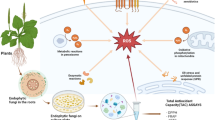Summary
The Basidiomycete fungi Coriolus versicolor and Hypholoma fasciculare were grown in liquid media containing 2, 20, 200 and 2,000 ppm nitrogen (as asparagine) and fed to cultures of Folsomia candida. Collembola feeding on both species of fungi exhibited trends of increased moulting and egg laying rates up to 200 ppm N and an inhibition of growth and fecundity at 2,000 ppm N. The differences in moulting rates between individual treatments were small for both species of fungi and not all the pair wise comparisons of treatments were significantly different. Egg laying rates of collembola fed C. versicolor showed a highly significant response to all levels of N in the growth medium and egg production at 200 ppm N was over three times higher than at 2 ppm N. Collembola fed H. fasciculare showed a less marked fecundity response to the different nitrogen levels and egg production at 200 ppm was approximately 1.5 times higher than at 2 ppm N. Both moulting and egg laying rates were significantly affected by the species of fungus presented as food to the collembola. The patterns of growth and reproduction of starved control groups of F. candida as well as those fed the test fungi demonstrate the adaptability of this species to changes in the quality and quantity of available food.
Similar content being viewed by others
References
Auclair, J.L.: Feeding and nutrition of the pea aphid, Acyrthosiphon pisum (Homoptera: Aphidae), on chemically defined diets of various pH and nutrient levels. Ann. Ent. Soc. Am. 58, 855–875 (1965)
Bärlocher, F., Kendrick, B.: Fungi in the diet of Gammarus pseudolimnaeus (Amphipoda). Oikos 24, 295–300 (1973)
Dowding, P.: Allocation of resources, nutrient uptake and release by decomposer organisms. In: The role of terestrial and aquatic organisms in decomposition processes (J.M. Anderson, A. Macfadyen, eds.), pp. 169–183. Oxford: Blackwell 1976
Fiennes, R.N. (ed.): Biology of nutrition. Oxford-New York: Pergamon Press 1972
Goto, H.E.: Simple techniques for the rearing of Collembola and a note on the use of a fungistatic substance in the cultures. Ent. Mon. Mag. 96, 138–140 (1960)
Green, C.D.: The effect of crowding upon the fecundity of Folsomia candida (Willem) var. distincta (Bagnall). Ent. Exp. and Appl. 7, 62–70 (1964)
Harding, D.J.L., Stuttard, R.A.: Microarthropods. In: Biology of plant litter decomposition (C.H. Dickinson, G.J.F. Pugh, eds.), pp. 489–532. London-New York: Academic Press 1974
Levi, M.P., Cowling, E.B.: Role of nitrogen in wood deterioration. VII. Physiological adaptation of wood-destroying and other fungi to substrates deficient in nitrogen. Phytopathology 59, 460–468 (1969)
Luxton, M.: Studies on the oribatid mites of a Danish beech wood soil. I. Nutritional biology. Pedobiologia 12, 434–463 (1972)
Marcus, J.H., Willoughby, L.G.: Fungi as food for the aquatic invertebrate Asellus aquaticus. Trans. Br. Mycol. Soc. 70, 143–146 (1978)
Marshall, V.G., Kevan, D.K.McE.: Preliminary observations on the biology of Folsomia candida Willem, 1902 (Collembola: Isotomidae). Can. Entomol. 94, 575–586 (1962)
Mills, J.T., Sinha, R.N.: Interactions between the springtail, Hypogastrura tullbergi, and soil-borne fungi. J. Econ. Ent. 64, 398–401 (1971)
Mitchell, M.J., Parkinson, D.: Fungal feeding of oribatid mites (Acari: Cryptostigmata) in an aspen woodland soil. Ecology 57, 302–312 (1976)
Park, D.: Nitrogen level and cellulose decomposition by fungi. Int. Biodetn. Bull. 12, 95–99 (1976)
Shereef, G.M.: Observations on the feeding, reproduction and faeces obtained from oribatids fed on different species of Penicillium and Aspergillus. In: IV. Colloqium Pedobiologiae, C.R. 4ème Coll. Int. Zool. Sol. (Anon, ed.), pp. 165–176. Paris: Inst. Nat. Recherche Agron. 1971
Snider, R.: Laboratory observations on the biolosy of Folsomia candida (Willem) (Collembola: Isotomidae). Rev. Ecol. Biol. Sol. 10, 103–124 (1973)
Snider, R.M., Butcher, J.W.: The life history of Folsomia candida (Willem) (Cellembola: Isotomidae) relative to temperature. Great Lakes Entomol. 6, 97–106 (1973)
Sokal, R.R., Rohlf, F.J.: Biometry, San Francisco: Freeman 1969
Swift, M.J.: Species diversity and the structure of microbial communities in terrestrial habitats. In: The role of terrestrial and aquatic organisms in decomposition processes (J.M. Anderson, A. Macfadyen, eds.), pp. 185–222. Oxford: Blackwell 1976
Watson, A. (ed.): Animal populations in relation to their food resources. Oxford: Blackwell 1970
Author information
Authors and Affiliations
Rights and permissions
About this article
Cite this article
Booth, R.G., Anderson, J.M. The influence of fungal food quality on the growth and fecundity of Folsomia candida (Collembola: Isotomidae). Oecologia 38, 317–323 (1979). https://doi.org/10.1007/BF00345191
Received:
Issue Date:
DOI: https://doi.org/10.1007/BF00345191




